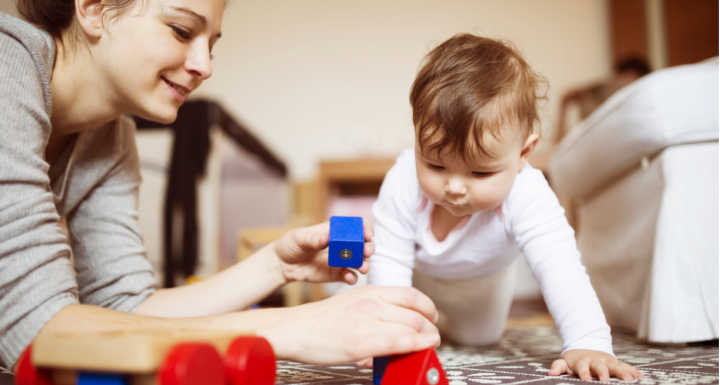Contact Us
High low, up down
Also known as the airplane game — a classic!
Materials: Willing baby and a mom feeling silly
What to Do: Sit on the floor with your child facing you. Gently place your socked feet on your child’s torso, grasping hands. Fly them over you as you roll gently down onto your back. Move your legs to create flying motion with child in the air.
Hint: Soar them ‘high!’ and ‘low!’ And make sure you’re wearing yoga pants — this counts as a core workout!
Variation: Start slowly if your child is more cautious, but when they are comfortable, feel free to add airplane sound effects and adjustthe flight for turbulence and such.
Opposites: 2 year old
An important thing to know!
Materials: An opaque container with a lid (like a wipes box or oatmeal container), various quiet items (sock, foam toy, tissue) and loud items (toy car, spoon, plastic letter)
What to Do: Place one item at a time into the container and have your little one shake it. Ask if it is quiet or LOUD!
Hint: You want the quiet items to make sound so you get quiet not silent. Check out some opposite books from the library before you dothis activity.
Variation: Talk about other opposite pairs — like things that are high (the sky, roof, tree) and low (grass, crawling, a mat), on and off, in and out.
Play a board game: 3 year old
You win some, you lose some.
Materials: A competitive board game (Blink, The Sneaky Snacky Squirrel, and Connect 4 are some good ones for ages 3 and up)
What to Do: Play the game with your child. Game-playing is a great way to help them experience the emotional high of winning and the low of losing on a small, manageable scale. Everybody loves to win, but no one wins all the time.
Hint: If your child is new to board games, try a luck-based game like Chutes and Ladders first, or a cooperative game like Count Your Chickens to get them used to game etiquette.
Variations: To level the playing field a bit, play in teams. Or give the adults and bigger kids a reasonable handicap (like extra cards in Blink), then play to win — with good sportsmanship, of course!
High low report: 4-5 year old
A better question than, ‘How was your day?’
Materials: Family mealtime, your family
What to Do: Everyone at the table answers the following question, ‘What was the high part of your day (when you felt happiest), and what was the low part of your day (when things were hard or you felt sad)?’
Hint: This is a wonderful family tradition and a great way to see how your child processes their day. Prompt them with things that happened throughout the day if they are stuck, but try not to answer for them. Rotate through who starts each night.
Variation: This is also a good game to play at bedtime.
What is your favorite question to ask your kids to learn about their day?

This originally appeared in Hello, Darling Spring 2015. If you didn’t get a copy and would like your own, you can subscribe to get Hello, Darling in your mailbox every season. If you subscribe, forward your receipt to magazines@mops.org and we’ll shoot a copy of the current issue in the mail to you for free … just because we like you.
Melissa Caddell is a writer and stay-in-the-car mom. She and her husband, Casey, are raising and driving around three chatty girls in Los Angeles. She writes from the relative quiet of her closet. Grab a cup of coffee and meet her at melissacaddell.com.
